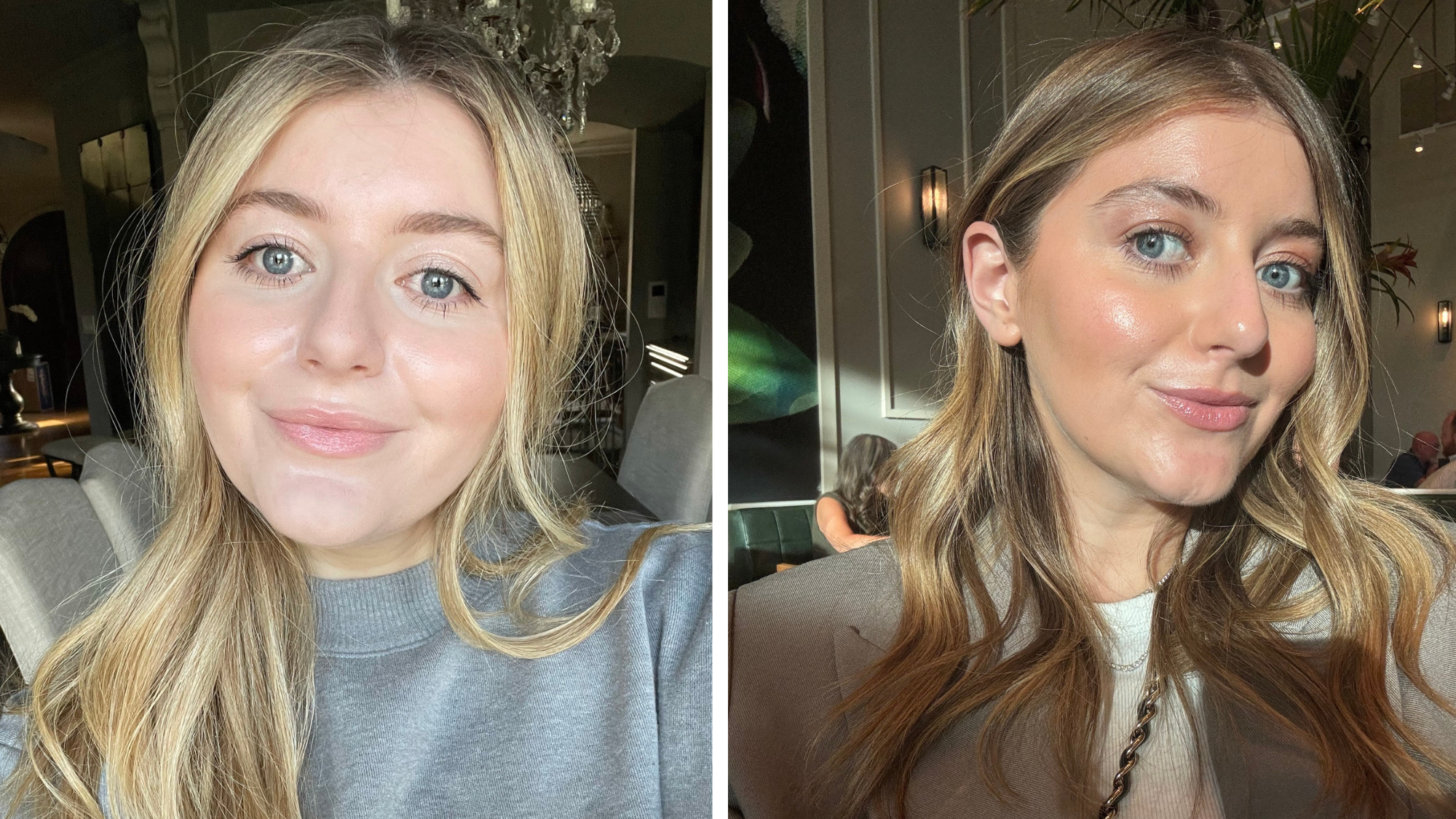
My face has always been a bit cherub-like: round cheeks, a circle shape, and a soft jawline. But when I was in my early 20s, my face changed—it puffed out to the point that it resembled a near-perfect circle; it didn’t look normal or healthy.
Concerned that something was seriously wrong, I saw a handful of doctors and specialists who ordered blood work panels to rule out diseases that can cause fat deposits to settle on the face, like Cushing’s syndrome and hypothyroidism. Thankfully, the tests came back negative but my doctors noted that my levels of cortisol (the “stress hormone”) were high.
There was no need for medication or extreme concern, but they said I was to “try to relax,” which, for a college student, is easier said than done. Still, I traded high-intensity HIIT for low-impact pilates, downloaded Calm, and even added Ashwagandha tea to my meal plan to reduce stress.
Could my higher-than-average cortisol levels have caused my face shape to change? They may have played a role, but they certainly weren’t the sole cause. Other factors could have been held responsible, too, including PCOS (a hormonal condition I have that can cause weight gain) and less-than-optimal lifestyle habits (I was sleeping only five hours a night and living on a steady diet of French fries and iced coffee).

Recently, TikTok has become obsessed with the idea that cortisol-induced stress can cause your face to become rounder and fuller. They’re calling it “cortisol face,” and nearly 100,000 users with "abnormally puffy" faces believe they have it—and that stress is the sole cause. They also think the solution can be found in natural remedies, nature meditation, special wellness drinks, gua sha rituals, or a woo-woo supplement purchased from TikTok Shop.
But here’s the thing: Stress-induced “cortisol face” isn’t real. It’s a buzzy (albeit misleading) term coined by social media.
“High stress does not result in sufficiently elevated levels of cortisol to present with cortisol face, which is also called moon face,” explains board-certified endocrinologist Caroline Messer, MD. “True cortisol face is caused by conditions that markedly increase cortisol in the body, including taking high doses of steroids or tumors that stimulate overproduction of cortisol.”
Cortisol face or moon face is a medical diagnosis—not a synonym for facial puffiness, water retention, or weight gain. Using the term as such has the potential to create a dangerous dialogue. “The harm of social media’s “cortisol face” lies in unnecessary worry and self-diagnosis. People might wrongly believe they have a hormonal imbalance and stress over it, potentially leading to unhealthy behaviors or treatments,” says double-board certified regenerative health and hormone expert Gowri Reddy Rocco, MD.
Here, I spoke with Dr. Rocco, Dr. Messer, functional medicine specialist Yana Delkah, MD, and board-certified dermatologist Paul Jarrod Frank, MD, to debunk the hype around the so-called “cortisol face.”
What Is Cortisol?
Cortisol is the body’s main stress hormone. “It’s responsible for many of the body's fight or flight responses,” explains Dr. Delkah. So, for example, if you were in danger, cortisol would spike and may signal other systems—like your digestive or immune systems—to take a back seat until the danger has passed.
When it’s functioning normally, cortisol is a good thing (despite the bad rap it’s receiving on TikTok). “Cortisol has several positive functions,” says Dr. Frank, noting that it can keep inflammation down and regulate blood pressure. It’s when levels are elevated for a prolonged period of time that the body gets out of whack.
What Is "Cortisol Face?"
What TikTokers are calling “cortisol face” is actually “moon face” or “moon facies,” to use the medical term. It's when the face gradually becomes rounder and fuller due to excess cortisol, explains Dr. Messer. Fat can deposit on the temples, below the cheekbones, and on the skull, making the face appear so puffy that “the ears are unable to be visualized, and the face becomes a near-perfect circle.”
The vast majority of suspected 'cortisol face' cases are actually due to weight gain and can be treated with diet, exercise, and weight loss medications.
Dr. Messer
But it’s important to understand that “moon face” is not the same as a run-of-the-mill puffiness or a round face shape. If you’re looking a little puffy, it could be due to many factors, including weight gain, salt consumption, and alcohol, explains Dr. Frank. Medical conditions, like PCOS, can also contribute to facial puffiness.
What Causes “Cortisol Face?”
True “moon face” may be the result of many factors, such as:
- Certain Medical Conditions: Moon face or cortisol face is typically caused by Cushing Syndrome, which occurs when “there is a pituitary tumor that releases high levels of cortisol,” explains Dr. Delkah. “You can also see moon face with hypothyroidism.” These diagnoses can be identified via bloodwork and a consultation with your doctor.
- Corticosteroids: According to Dr. Messer, prolonged use of steroids, like prednisone, can also lead to moon face. Using steroids for a long time causes your adrenal glands to release large amounts of hormones, including cortisol; this can lead to swelling around your face, per the Cleveland Clinic.
- Poor Lifestyle Habits: “High cortisol levels can be triggered by a lack of sleep, not exercising, poor stress management, excessive caffeine, and consumption of highly processed foods,” explains Dr. Rocco. While these habits may contribute to elevated cortisol, they’re unlikely to be the sole cause of moon face.
-
Stress: Similarly, stress can play a role in raising cortisol levels—but it won’t singlehandedly cause "cortisol face." Rather, it’s just “a piece of the puzzle and not the sole cause,” says Dr. Frank. That being said, “having high cortisol levels due to stress or lifestyle should be watched and controlled so that it doesn’t become a problem later in life,” notes Dr. Yana.
Is “Cortisol Face” Real?
Let’s be clear: True “moon face” that’s caused by diseases like Cushing’s syndrome is a real thing. But Cushing’s syndrome only affects 10 to 15 people per million a year, so it’s quite frankly impossible that the hundreds of thousands of people on TikTok are all suffering from it.
“The vast majority of suspected 'cortisol face' cases are actually due to weight gain and can be treated with diet, exercise, and weight loss medications,” says Dr. Messer. “Very often, a rounded face mimics a cortisol face in appearance, but it is not due to excess cortisol.”
How Do I Know If I Have “Cortisol Face?”
If you’re worried you have moon face, make an appointment with your board-certified primary care doctor or endocrinologist. They can check your blood, saliva, and urine for high cortisol levels.
The bottom line is this: “You cannot look at someone and tell if they have cortisol face,” explains Dr. Frank. “People have varying degrees of face shapes. If you notice changes in your face, cortisol can contribute, but you typically can’t tell from across the room.”
How to Get Rid of “Cortisol Face”
Consult with your physician before doing anything. Do not self-treat or take yourself off any medication. “Know that this is not something that happens quickly. It takes such a long time to identify what causes high cortisol, but then it also takes a long time to decrease your cortisol levels and put your body back in a level of homeostasis,” says Dr. Delkah.
How to Get Rid of a Puffy Face, in General
Even if you don’t have true “moon face,” there are things you can do to de-puff your face—without medical intervention. Here’s what the experts recommend:
- Eat a Healthy Diet: Contrary to what you may hear on TikTok, most supplements aren’t going to get you very far. If you want to reduce inflammation, it’s better to get your nutrients from food. “Any foods or vitamins with high antioxidant function—like the B vitamins, omega and fish oil, things with magnesium in it, specialized doses of glutathione or CoQ10—really makes a difference after a few months,” says Dr. Delkah. To reap the benefits, incorporate fatty fish, leafy greens, beans, and seeds into your diet. It’s also helpful to reduce your refined sugar and alcohol intake and stay hydrated with water and electrolytes, notes Dr. Rocco.
- Use a Facial Roller: If you find that your face looks and feels swollen, consider incorporating a facial massage tool, like a gua sha, jade roller, or microcurrent device, into your daily skincare routine. “This may increase some level of lymphatic drainage in the face, which can temporarily reduce swelling,” board-certified dermatologist Melissa Kanchanapoomi Levin, MD, previously told Marie Claire.
- Sleep on Your Back: “I tell patients to add an extra pillow to fight against gravity,” board-certified dermatologist Dhaval Bhanusali, MD, FAAD, told Marie Claire.“This is one of the easiest ways to prevent bloating because it reduces the amount of fluid retained in the face.”
When Should I See a Doctor About “Cortisol Face?”
You should call your doctor if, in addition to a puffy face, you’re experiencing other tell-tale signs of Cushing’s syndrome, says Dr. Messer. These include: high blood pressure, bone loss/fractures, easy bruising, slow wound healing, thinning arms and legs, weight gain in the trunk, stretch marks on the stomach, hips, thighs, breasts and underarms, acne, excessive sweating, fatigue, muscle weakness, and menstrual changes.







